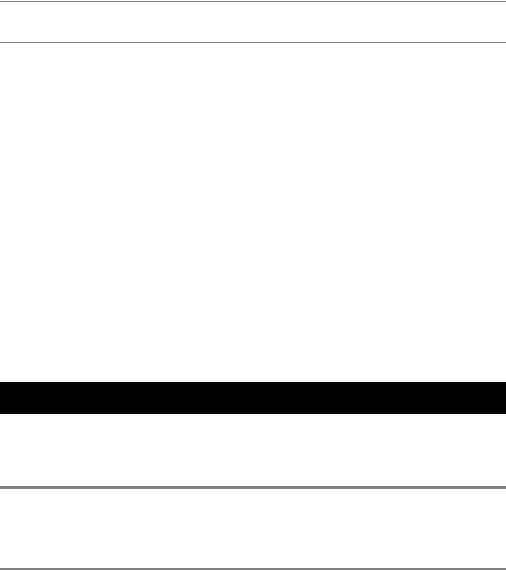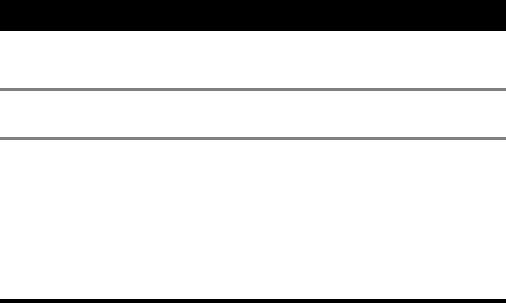
Beginning Python - From Novice To Professional (2005)
.pdf30 |
C H A P T E R 1 ■ I N S T A N T H A C K I N G : T H E B A S I C S |
Strings. Strings are really simple—they are just pieces of text. And yet there is a lot to know about them. In this chapter, you’ve seen many ways to write them, and in Chapter 3 you learn many ways of using them.
New Functions in This Chapter
Function |
Description |
abs(number) |
Returns the absolute value of a number |
cmath.sqrt(number) |
Square root, also for negative numbers |
float(object) |
Converts a string or number to a floating-point number |
help() |
Offers interactive help |
input(prompt) |
Gets input from the user |
int(object) |
Converts a string or number to an integer |
long(object) |
Converts a string or number to a long integer |
math.ceil(number) |
Returns the ceiling of a number as a float |
math.floor(number) |
Returns the floor of a number as a float |
math.sqrt(number) |
Square root, not for negative numbers |
pow(x, y[, z]) |
x to the power of y (modulo z) |
raw_input(prompt) |
Gets input from the user, as a string |
repr(object) |
Returns a string-representation of a value |
round(number[, ndigits]) |
Rounds a number to a given precision |
str(object) |
Converts a value to a string |
|
|
What Now?
Now that you know the basics of expressions, let’s move on to something a bit more advanced: data structures. Instead of dealing with simple values (such as numbers), you’ll see how to bunch them together in more complex structures, such as lists and dictionaries. In addition, you’ll take another close look at strings. In Chapter 5, you learn more about statements, and after that you’ll be ready to write some really nifty programs.

C H A P T E R 2
■ ■ ■
Lists and Tuples
This chapter introduces a new concept: data structures. A data structure is a collection of data elements (such as numbers or characters—or even other data structures) that is structured in some way, for example, by numbering the elements. The most basic data structure in Python is the sequence. Each element of a sequence is assigned a number—its position, or index. The first index is zero, the second index is one, and so forth.
■Note When you count or number things in your daily life, you probably start counting from 1. The numbering scheme used in Python may seem odd, but it is actually quite natural. One of the reasons for this, as you see later in the chapter, is that you can also count from the end: The last item of a sequence is numbered –1, the next-to-last –2, and so forth. That means you can count forward or backward from the first element, which lies at the beginning, or zero. Trust me, you get used to it.
Python has six built-in types of sequences, but let’s concentrate on two of the most common ones—lists and tuples. The main difference between these is that you can change a list, but you can’t change a tuple. This means a list might be useful if you need to add elements as you go along, while a tuple can be useful if, for some reason, you can’t allow the sequence to change. Reasons for the latter are usually rather technical, having to do with how things work internally in Python. That’s why you may see built-in functions returning tuples. For your own programs, chances are you can use lists instead of tuples in almost all circumstances. (One notable exception, as described in Chapter 4, is using tuples as dictionary keys. There lists aren’t allowed, because you aren’t allowed to modify keys.)
■Note The other built-in sequence types are strings (which I revisit in the next chapter), Unicode strings, buffer objects, and xrange objects.
31

32 |
C H A P T E R 2 ■ L I S T S A N D T U P L E S |
Sequences are useful when you want to work with a collection of values. You might have a sequence representing a person in a database, with the first element being their name, and the second their age. Written as a list (the items of a list are separated by commas and enclosed in square brackets), that would look like this:
>>> edward = ['Edward Gumby', 42]
But sequences can contain other sequences, too, so you could make a list of such persons, which would be your database:
>>>edward = ['Edward Gumby', 42]
>>>john = ['John Smith', 50]
>>>database = [edward, john]
>>>database
[['Edward Gumby', 42], ['John Smith', 50]]
This chapter begins with some operations that are common to all sequences, including lists and tuples. These operations will also work with strings, which will be used in some of the examples, although for a full treatment of string operations, you have to wait until the next chapter.
After dealing with these basics, we start working with lists and see what’s special about them. After lists, we come to tuples, which are very similar to lists, except that you can’t change them.
■Note Python has a basic notion of a kind of data structure called a container, which is basically any object that can contain other objects. The two main kinds of containers are sequences (such as lists and tuples) and mappings (such as dictionaries). While the elements of a sequence are numbered, each element in a mapping has a name (also called a key). You learn more about mappings in Chapter 4. For an example of a container type that is neither a sequence nor a mapping, see the discussion of sets in Chapter 10.
Common Sequence Operations
There are certain things you can do with all sequence types. These operations include indexing, slicing, adding, multiplying, and checking for membership. In addition, Python has built-in functions for finding the length of a sequence, and for finding its largest and smallest elements.
■Note One important operation not covered here is iteration. To iterate over a sequence means to perform certain actions repeatedly, once per element in the sequence. To learn more about this, see the section “Loops” in Chapter 5.

C H A P T E R 2 ■ L I S T S A N D T U P L E S |
33 |
Indexing
All elements in a sequence are numbered—from zero and upwards. You can access them individually with a number, like this:
>>>greeting = 'Hello'
>>>greeting[0]
'H'
■Note A string is just a sequence of characters. The index 0 refers to the first element, in this case the letter H.
This is called indexing—you use an index to fetch an element. All sequences can be indexed in this way. When you use a negative index, Python counts from the right, that is, from the last element. The last element is at position –1 (not –0, as that would be the same as the first element):
>>> greeting[-1] 'o'
String literals (and other sequence literals, for that matter) may be indexed directly, without using a variable to refer to them. The effect is exactly the same:
>>> 'Hello'[1] 'e'
If a function call returns a sequence, you can index it directly. For instance, if you are simply interested in the fourth digit in a year entered by the user, you could do something like this:
>>>fourth = raw_input('Year: ')[3] Year: 2005
>>>fourth
'5'
Example
Listing 2-1 contains an example program that asks you for a year, a month (as a number from 1 to 12), and a day (1 to 31), and then prints out the date with the proper month name and so on. An example session with this program might be as follows:
Year: 1974
Month (1-12): 8
Day (1-31): 16
August 16th, 1974
The last line is the output from the program.

34 |
C H A P T E R 2 ■ L I S T S A N D T U P L E S |
Listing 2-1. Indexing Example
# Print out a date, given year, month, and day as numbers
months = [ 'January', 'February', 'March', 'April', 'May', 'June', 'July', 'August', 'September', 'October', 'November', 'December'
]
# A list with one ending for each number from 1 to 31 endings = ['st', 'nd', 'rd'] + 17 * ['th'] \
+ ['st', 'nd', 'rd'] + 7 * ['th'] \ + ['st']
year |
= raw_input('Year: |
') |
|
month |
= |
raw_input('Month |
(1-12): ') |
day |
= |
raw_input('Day (1-31): ') |
|
month_number = int(month) day_number = int(day)
# Remember to subtract 1 from month and day to get a correct index month_name = months[month_number-1]
ordinal = day + endings[day_number-1]
print month_name + ' ' + ordinal + ', ' + year
Slicing
Just as you use indexing to access individual elements, you can use slicing to access ranges of elements. You do this by using two indices, separated by a colon:
>>>tag = '<a href="http://www.python.org">Python web site</a>'
>>>tag[9:30]
'http://www.python.org'
>>> tag[32:-4] 'Python web site'
C H A P T E R 2 ■ L I S T S A N D T U P L E S |
35 |
As you can see, slicing is very useful for extracting parts of a sequence. The numbering here is very important. The first index is the number of the first element you want to include. However, the last index is the number of the first element after your slice. Consider the following:
>>>numbers = [1, 2, 3, 4, 5, 6, 7, 8, 9, 10]
>>>numbers[3:6]
[4, 5, 6]
>>> numbers[0:1] [1]
In short, you supply two indices as limits for your slice, where the first is inclusive, and the second is exclusive.
A Nifty Shortcut
Let’s say you want to access the last three elements of numbers (from the previous example). You could do it explicitly, of course:
>>> numbers[7:10] [8, 9, 10]
Now, the index 10 refers to element 11—which does not exist, but is one step after the last element you want. Got it?
Now, this is fine, but what if you want to count from the end?
>>> numbers[-3:-1] [8, 9]
It seems you cannot access the last element this way. How about using 0 as the element “one step beyond” the end?
>>> numbers[-3:0] []
Not exactly the desired result. In fact, any time the leftmost index in a slice comes later in the sequence than the second one (in this case, the third-to-last coming later than the first), the result is always an empty sequence. Luckily, you can use a shortcut: If the slice continues to the end of the sequence, you may simply leave out the last index:
>>> numbers[-3:] [8, 9, 10]
The same thing works from the beginning:
>>> numbers[:3] [1, 2, 3]
In fact, if you want to copy the entire sequence, you may leave out both indices:
>>> numbers[:]
[1, 2, 3, 4, 5, 6, 7, 8, 9, 10]

36 |
C H A P T E R 2 ■ L I S T S A N D T U P L E S |
Example
Listing 2-2 contains a small program that prompts you for a URL, and (assuming it is of the form http:// www.somedomainname.com) extracts the domain name. Here is a sample run of the program:
Please enter the URL: http://www.python.org
Domain name: python
Listing 2-2. Slicing Example
# Split up a URL of the form http://www.something.com
url = raw_input('Please enter the URL: ') domain = url[11:-4]
print "Domain name: " + domain
Longer Steps
When slicing, you specify (either explicitly or implicitly) the start and end points of the slice. Another parameter (added to the built-in types in Python 2.3), which normally is left implicit, is the step length. In a regular slice, the step length is one—the slice “moves” from one element to the next, returning all the elements between the start and end:
>>> numbers[0:10:1]
[1, 2, 3, 4, 5, 6, 7, 8, 9, 10]
In this example, you can see that the slice includes another number. This is, as you may have guessed, the step size, made explicit. If the step size is set to a number greater than one, elements will be skipped. For example, a step size of two will include only every other element of the interval between the start and the end:
>>> numbers[0:10:2] [1, 3, 5, 7, 9] numbers[3:6:3]
[4]
You can still use the shortcuts mentioned earlier; if you want every fourth element of a sequence, you only have to supply a step size of four:
>>> numbers[::4] [1, 5, 9]
Naturally, the step size can’t be zero—that wouldn’t get you anywhere—but it can be negative, which means extracting the elements from right to left:
C H A P T E R 2 ■ L I S T S A N D T U P L E S |
37 |
>>>numbers[8:3:-1] [9, 8, 7, 6, 5]
>>>numbers[10:0:-2] [10, 8, 6, 4, 2]
>>>numbers[0:10:-2]
[]
>>>numbers[::-2] [10, 8, 6, 4, 2]
>>>numbers[5::-2] [6, 4, 2]
>>>numbers[:5:-2] [10, 8]
Getting things right here can involve a bit of thinking. As you can see, the first limit (the leftmost) is still inclusive, while the second (the rightmost) is exclusive. When using a negative step size, you have to have a first limit (start index) that is higher than the second one. What may be a bit confusing is that when you leave the start and end indices implicit, Python does the “right thing” here; for a positive step size it moves from the beginning toward the end, and for a negative step size it moves from the end toward the beginning.
Adding Sequences
Sequences can be concatenated with the addition (plus) operator:
>>>[1, 2, 3] + [4, 5, 6] [1, 2, 3, 4, 5, 6]
>>>'Hello, ' + 'world!' 'Hello, world!'
>>>[1, 2, 3] + 'world!' Traceback (innermost last):
File "<pyshell#2>", line 1, in ? [1, 2, 3] + 'world!'
TypeError: can only concatenate list (not "string") to list
As you can see from the error message, you can’t concatenate a list and a string, although both are sequences. In general, you can only concatenate two sequences of the same kind.
Multiplication
Multiplying a sequence by a number x creates a new sequence where the original sequence is repeated x times:
>>>'python' * 5 'pythonpythonpythonpythonpython'
>>>[42] * 10
[42, 42, 42, 42, 42, 42, 42, 42, 42, 42]
38 |
C H A P T E R 2 ■ L I S T S A N D T U P L E S |
None, Empty Lists, and Initialization
An empty list is simply written as two brackets ([])—there’s nothing in it. But what if you want to have a list with room for ten elements but with nothing useful in it? You could use [42]*10, as before, or perhaps more realistically [0]*10. You now have a list with ten zeros in it. Sometimes, however, you would like a value that somehow means “nothing,” as in “we haven’t put anything here yet.” That’s when you use None. None is a Python value and means exactly that— “nothing here.” So if you want to initialize a list of length 10, you could do the following:
>>>sequence = [None] * 10
>>>sequence
[None, None, None, None, None, None, None, None, None, None]
Listing 2-3 contains a program that prints (to the screen) a “box” made up of characters, which is centered on the screen and adapted to the size of a sentence supplied by the user. The following is a sample run:
Sentence: He's a very naughty boy!
+——————————————————————————+
| |
| He's a very naughty boy! |
| |
+——————————————————————————+
The code may look complicated, but it’s basically just arithmetic—figuring out how many spaces, dashes, and so on you need in order to place things correctly.
Listing 2-3. Sequence (String) Multiplication Example
#Prints a sentence in a centered "box" of correct width
#Note that the integer division operator (//) only works in Python
#2.2 and newer. In earlier versions, simply use plain division (/)
sentence = raw_input("Sentence: ")
screen_width |
= 80 |
|
text_width |
= len(sentence) |
|
box_width |
= |
text_width + 6 |
left_margin |
= |
(screen_width - box_width) // 2 |
|
|
|
|
|
print ' ' * left_margin + '+' |
+ '-' |
* (box_width-2) |
+ |
'+' |
print ' ' * left_margin + '| |
' + ' ' |
* text_width |
+ ' |
|' |
print ' ' * left_margin + '| |
' + |
sentence |
+ ' |
|' |
print ' ' * left_margin + '| |
' + ' ' |
* text_width |
+ ' |
|' |
print ' ' * left_margin + '+' |
+ '-' |
* (box_width-2) |
+ |
'+' |
|
|
|
|

C H A P T E R 2 ■ L I S T S A N D T U P L E S |
39 |
Membership
To check whether a value can be found in a sequence, you use the in operator. This operator is a bit different from the ones discussed so far (such as multiplication or addition). It checks whether something is true, and returns a value accordingly: True for true and False for false. Such operators are called Boolean operators, and the truth values are called Boolean values. You learn more about Boolean expressions in the section on conditional statements in Chapter 5.
Here are some examples that use the in operator:
>>>permissions = 'rw'
>>>'w' in permissions
True
>>>'x' in permissions False
>>>users = ['mlh', 'foo', 'bar']
>>>raw_input('Enter your user name: ') in users Enter your user name: mlh
True
>>>subject = '$$$ Get rich now!!! $$$'
>>>'$$$' in subject
True
The first two examples use the membership test to check whether 'w' and 'x' respectively are found in the string permissions. This could be a script on a UNIX machine checking for writing and execution permissions on a file. The next example checks whether a supplied user name (mlh) is found in a list of users. This could be useful if your program enforces some security policy. (In that case, you would probably want to use passwords as well.) The last example could be a part of a spam filter, for example—it checks whether the string subject contains the string '$$$'.
■Note The last example is a bit different from the others. In general, the in operator checks whether an object is a member (that is, an element) of a sequence (or some other collection). However, the only members or elements of a string are its characters. So, the following makes perfect sense:
>>> 'P' in 'Python' True
In fact, in earlier versions of Python this was the only membership check that worked with strings—finding out whether a character is found in a string. Trying to check for a longer substring, such as '$$$', would give you an error message (it would raise a TypeError), and you’d have to use a string method. You learn more about those in Chapter 3. From Python 2.3, however, you can use the in operator to check whether any string is a substring of another.
Listing 2-4 shows a program that reads in a user name and checks the entered PIN code against a database (a list, actually) that contains pairs (more lists) of names and PIN codes. If
